Death metal is characterized by aggressive guitar riffs, growled vocals, and complex song structures. This article explores its key characteristics, diverse influences, and the iconic bands that have shaped the genre. It also examines the cultural context, subgenres, and challenges faced by musicians today. Understanding these elements provides insight into the evolution and significance of death metal in the music landscape.
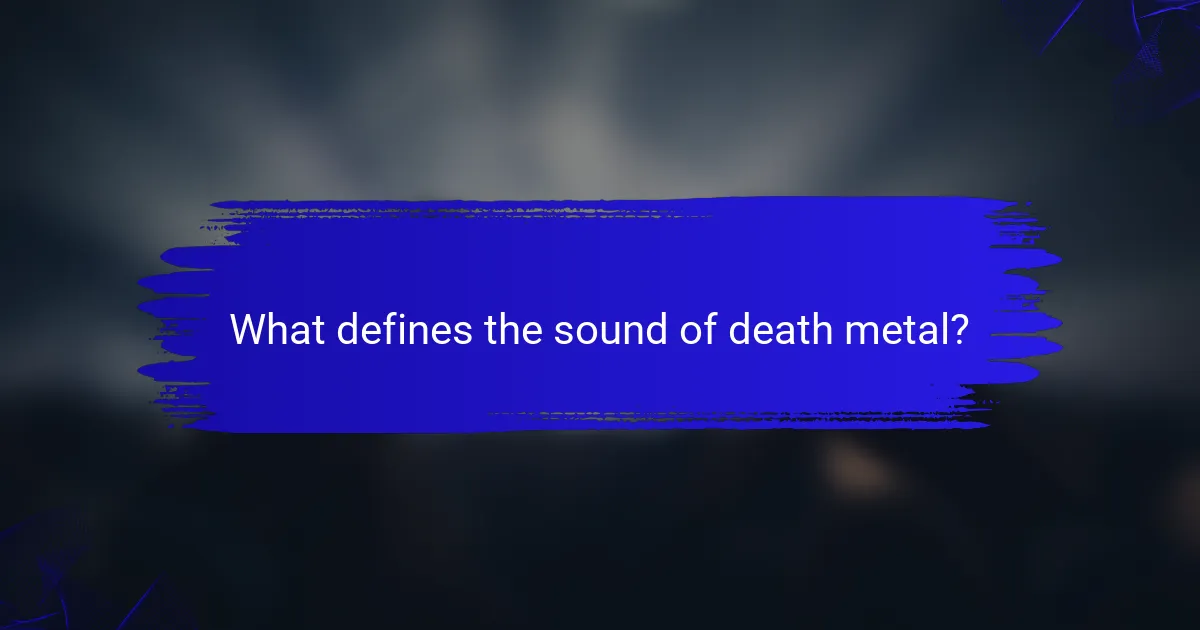
What defines the sound of death metal?
The sound of death metal is defined by its aggressive guitar riffs, growled vocals, and complex song structures. Key characteristics include fast tempos, heavy distortion, and intricate drumming patterns. Influences range from thrash and black metal to punk, creating a unique sonic experience. Iconic bands such as Death, Cannibal Corpse, and Morbid Angel exemplify these elements, pushing the genre’s boundaries.
How do tempo and rhythm influence death metal?
Tempo and rhythm significantly shape the intensity and emotional impact of death metal. Fast tempos create a sense of urgency, while varied rhythms enhance complexity. Iconic bands like Death and Cannibal Corpse utilize these elements to convey aggression and darkness, establishing a unique sound that defines the genre. The interplay of tempo and rhythm allows for dynamic shifts, contributing to the genre’s overall atmosphere and energy.
What role do guitar techniques play in shaping death metal?
Guitar techniques are crucial in shaping death metal by defining its sound and complexity. Techniques such as palm muting, tremolo picking, and sweep picking create aggressive rhythms and intricate solos. These methods contribute to the genre’s signature intensity and technical proficiency. Iconic bands like Death and Cannibal Corpse utilize these techniques to enhance their musical identity and influence. The unique attribute of rapid tempo changes and complex time signatures further distinguishes death metal from other genres.
How do vocal styles vary within the genre?
Vocal styles in death metal vary significantly, showcasing diverse techniques and emotional expressions. Key styles include growling, screaming, and clean vocals, each contributing to the genre’s intensity.
Growling is a dominant style, characterized by deep, guttural sounds, often used to convey aggression. Screaming, on the other hand, features higher-pitched, piercing vocals that add a sense of urgency. Clean vocals, though less common, can introduce melodic elements, enhancing contrast within songs.
Influential bands like Cannibal Corpse and Death exemplify these vocal variations. Cannibal Corpse utilizes harsh growls, while Death incorporated a mix of growling and melodic singing, showcasing the genre’s range. This diversity in vocal styles enriches the overall sound and emotional impact of death metal.
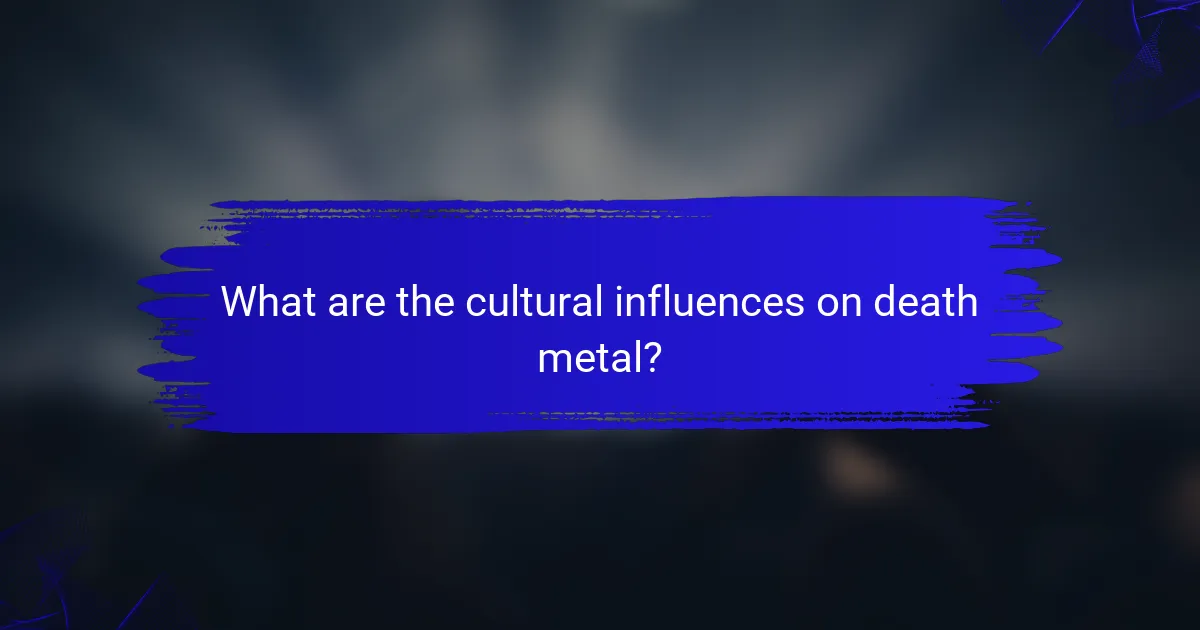
What are the cultural influences on death metal?
Cultural influences on death metal include a blend of extreme musical styles, literary themes, and visual aesthetics. The genre draws inspiration from horror films, mythology, and societal issues, creating a unique sound and identity. Bands like Slayer and Cannibal Corpse incorporate themes of violence and existential dread, reflecting cultural anxieties. Additionally, the DIY ethic from punk rock and the underground metal scene fosters a sense of community and rebellion, further shaping death metal’s cultural landscape.
Which subcultures have shaped death metal’s evolution?
Various subcultures have significantly influenced the evolution of death metal, including punk, thrash metal, and horror fiction. Punk’s aggressive ethos contributed to death metal’s raw sound and rebellious attitude. Thrash metal’s speed and technicality shaped the genre’s musical complexity. Additionally, horror fiction’s themes and imagery inspired lyrical content and aesthetic elements in death metal. Iconic bands like Death and Morbid Angel emerged from these influences, establishing key characteristics that define the genre today.
How do regional styles contribute to the genre’s diversity?
Regional styles significantly enhance the diversity of death metal by incorporating local musical influences and cultural themes. For instance, Scandinavian death metal often features melodic elements, while Floridian styles emphasize speed and aggression. This variety allows for a rich tapestry of sounds and lyrical themes, reflecting unique regional identities. Iconic bands like At the Gates and Morbid Angel exemplify these distinct characteristics, showcasing how regional influences shape the genre’s evolution.
![]()
Which iconic bands have defined the death metal landscape?
Iconic bands that have defined the death metal landscape include Death, Cannibal Corpse, Morbid Angel, and Obituary. These bands shaped the genre with their unique sound, complex song structures, and lyrical themes. Death pioneered technical death metal, while Cannibal Corpse is known for their graphic lyrics and aggressive style. Morbid Angel introduced elements of melody and atmosphere, contributing to the genre’s evolution. Obituary’s heavy riffs and growled vocals set a standard for the Florida death metal scene. Each band has left an indelible mark, influencing countless artists and the overall sound of death metal.
What contributions did Death make to the genre?
Death significantly shaped the death metal genre through innovative musical techniques and lyrical themes. Their complex song structures and technical proficiency set a new standard for musicianship. The band’s incorporation of diverse influences, including thrash and progressive metal, expanded the genre’s boundaries. Death’s exploration of philosophical and existential themes in lyrics distinguished them from contemporaries, influencing countless bands that followed. Their seminal albums, particularly “Symbolic” and “Human,” are often cited as pivotal moments in death metal history.
How did Cannibal Corpse influence death metal’s popularity?
Cannibal Corpse significantly boosted death metal’s popularity through their extreme sound and graphic lyrics. Their unique attributes include relentless guitar riffs, aggressive drumming, and controversial album artwork, which captured attention. Their influence is evident in the rise of similar bands and the expansion of the genre into mainstream consciousness. As a result, Cannibal Corpse helped define death metal’s identity and broaden its audience.
What is the significance of Morbid Angel in death metal history?
Morbid Angel is significant in death metal history for pioneering the genre’s sound and aesthetics. Their innovative approach combined elements of thrash and black metal, setting a template for future bands. The album “Altars of Madness,” released in 1989, is often cited as a landmark in death metal, showcasing complex song structures and lyrical themes of horror and the occult. Morbid Angel’s influence extends to countless bands, solidifying their status as one of the genre’s most iconic acts. Their unique attribute lies in their technical proficiency and the incorporation of progressive elements, which distinguished them from contemporaries.
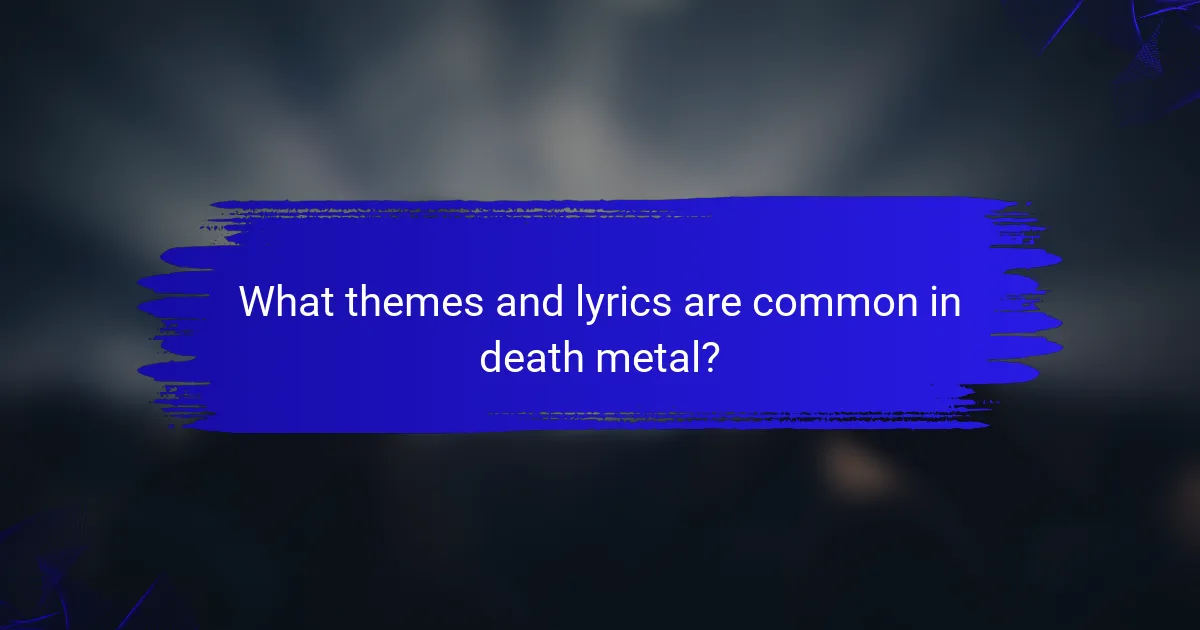
What themes and lyrics are common in death metal?
Death metal commonly features themes of death, violence, and existentialism. Lyrics often explore horror, mythology, and social issues, using graphic imagery and complex structures. Iconic bands like Death, Cannibal Corpse, and Morbid Angel exemplify these characteristics, contributing to the genre’s distinct sound and lyrical depth.
How do horror and existential themes manifest in lyrics?
Horror and existential themes in death metal lyrics often explore mortality, despair, and the human condition. These themes manifest through vivid imagery, graphic descriptions, and philosophical inquiries. Iconic bands like Cannibal Corpse and Death frequently incorporate these elements, reflecting a unique attribute of the genre that challenges listeners’ perceptions of life and death. The raw emotion and intensity of the music amplify the impact of these themes, creating a profound connection with the audience.
What storytelling techniques are prevalent in death metal songs?
Death metal songs often employ storytelling techniques that convey dark themes, complex narratives, and vivid imagery. Common techniques include metaphorical language, vivid descriptions, and character-driven plots.
Lyrics frequently explore topics such as death, violence, and existentialism, often using allegory and symbolism. For instance, some bands create fictional narratives or draw from horror literature, enhancing the emotional impact.
Unique attributes of death metal storytelling include its use of extreme contrasts, such as juxtaposing brutality with moments of introspection. This complexity allows for a deeper exploration of human emotions and societal issues.
Iconic bands like Death and Cannibal Corpse exemplify these techniques, crafting songs that resonate with fans through their intricate storytelling and thematic depth.
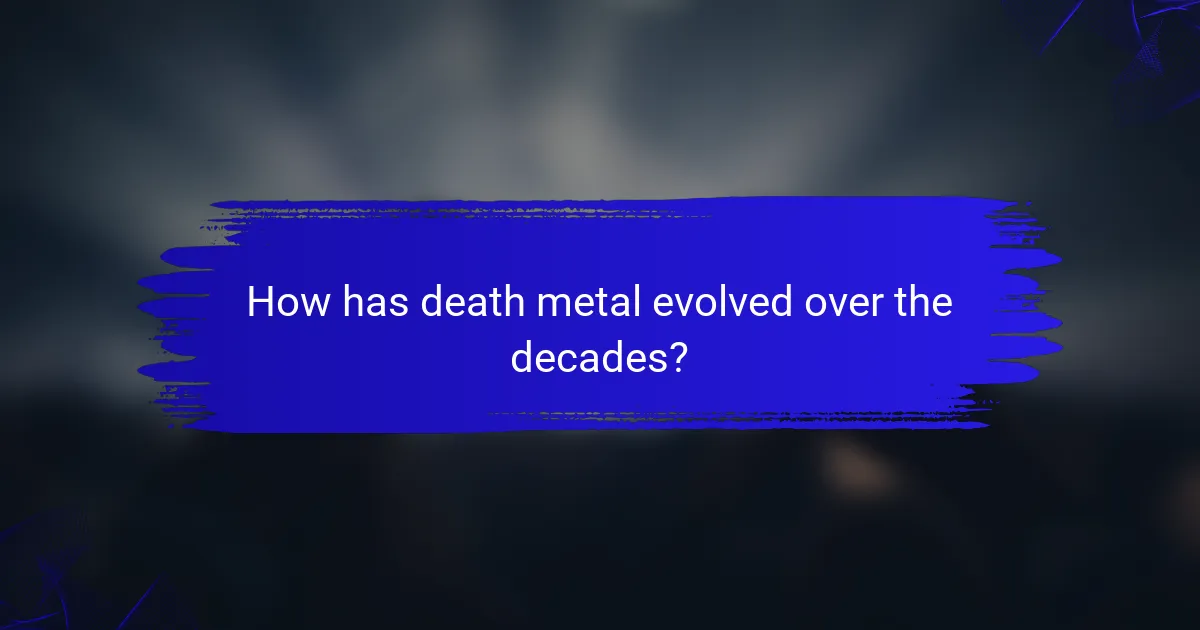
How has death metal evolved over the decades?
Death metal has evolved significantly over the decades, characterized by increased complexity and diversity. Initially emerging in the mid-1980s, it incorporated elements from thrash metal and hardcore punk. Influential bands like Death and Morbid Angel established foundational sounds with intricate guitar work and guttural vocals.
In the 1990s, the genre diversified further, introducing melodic and technical elements, exemplified by bands such as Opeth and At the Gates. The emergence of subgenres like melodic death metal and brutal death metal expanded its reach.
By the 2000s, death metal saw a resurgence with bands like Behemoth and The Black Dahlia Murder, blending influences from black metal and other genres. This evolution reflects a broader acceptance of heavy music, leading to innovative sounds and complex compositions.
Today, death metal continues to thrive, with bands exploring themes and styles that push the genre’s boundaries, ensuring its relevance in the music scene.
What were the key developments in the 1990s?
The 1990s saw significant developments in death metal, characterized by technical complexity and diverse influences. Bands like Death and Morbid Angel pioneered the genre, integrating elements from thrash and black metal. The emergence of subgenres such as melodic death metal and brutal death metal expanded its appeal, with bands like At The Gates and Cannibal Corpse leading the way. This era solidified the genre’s identity and established a dedicated fan base.
How did the 2000s reshape the sound of death metal?
The 2000s significantly reshaped death metal by incorporating diverse influences and evolving its sound. Bands began to blend elements from other genres, such as metalcore and progressive rock, leading to increased technicality and melodic structures. The emergence of subgenres like melodic death metal gained traction, characterized by harmonized guitar riffs and clean vocal segments. Iconic bands such as Arch Enemy and Shadows Fall exemplified this shift, pushing boundaries while maintaining the genre’s intensity. Additionally, advancements in production technology allowed for clearer and more polished recordings, further enhancing the overall sound quality.
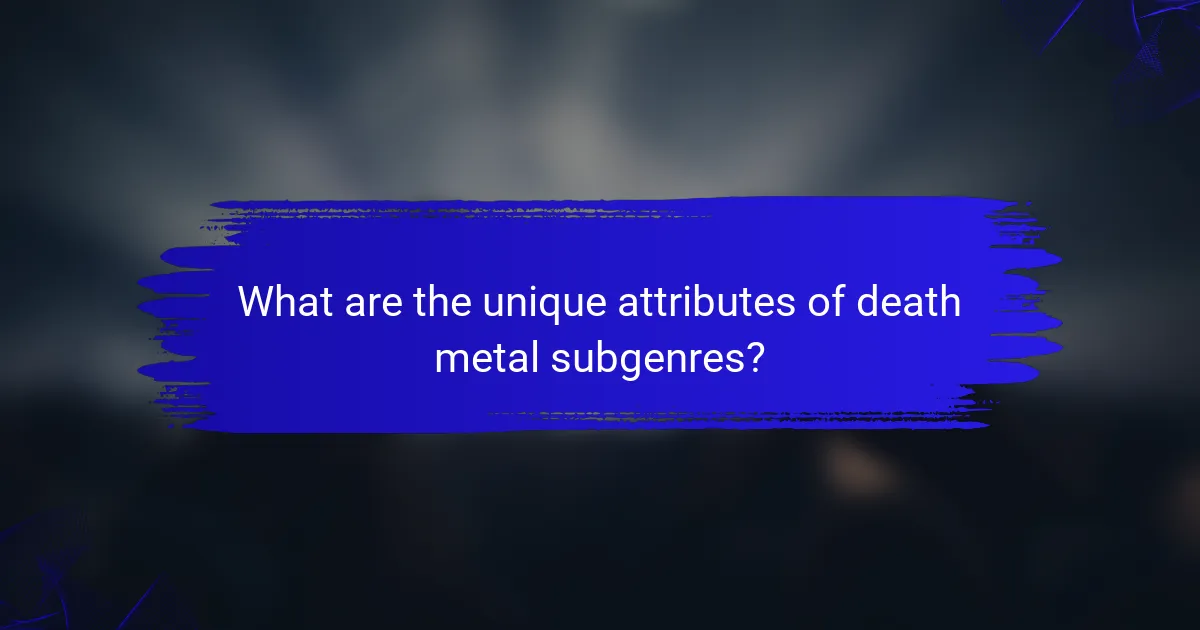
What are the unique attributes of death metal subgenres?
Death metal subgenres possess unique attributes that differentiate them. Key subgenres include melodic death metal, characterized by harmonized guitar melodies; technical death metal, known for complex rhythms and musicianship; and brutal death metal, which emphasizes extreme aggression and guttural vocals. Each subgenre reflects distinct influences and stylistic elements, contributing to the overall diversity of death metal. Iconic bands like At The Gates, Death, and Cannibal Corpse exemplify these unique characteristics, shaping the genre’s evolution.
How does melodic death metal differ from traditional death metal?
Melodic death metal features melodic elements and harmonies, setting it apart from traditional death metal’s focus on aggression and brutality. Melodic death metal incorporates clean vocals and guitar solos, while traditional death metal emphasizes growled vocals and complex rhythms. Iconic bands like In Flames and At the Gates exemplify melodic death metal, contrasting with Cannibal Corpse and Morbid Angel, which represent traditional death metal. This distinction highlights the evolution of death metal, showcasing its diverse influences and characteristics.
What distinguishes technical death metal from other styles?
Technical death metal is distinguished by complex song structures, intricate guitar work, and advanced musical techniques. Unlike other styles of death metal, it incorporates progressive elements, jazz influences, and technical proficiency. Iconic bands like Death and Cynic exemplify these characteristics, showcasing a blend of melody and aggression. The unique attribute of technical death metal is its emphasis on musicianship, often featuring time signature changes and elaborate solos that set it apart from more straightforward forms of metal.
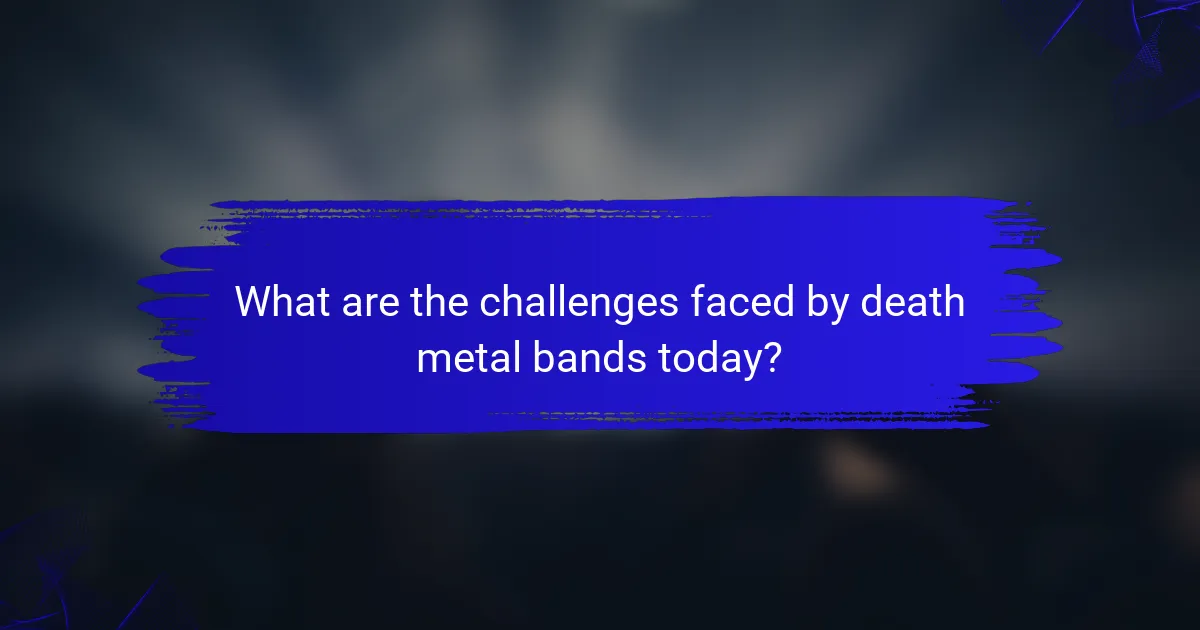
What are the challenges faced by death metal bands today?
Death metal bands face numerous challenges today, including competition, evolving musical trends, and financial instability. The genre’s distinct characteristics, such as aggressive sound and complex compositions, struggle to attract mainstream audiences. Iconic bands often deal with the pressure of maintaining their legacy while appealing to new fans. Additionally, the rise of digital streaming has changed revenue models, making it harder for bands to sustain themselves financially. The genre’s underground roots can limit exposure, further complicating opportunities for growth and recognition.
How do bands navigate the music industry landscape?
Death metal bands navigate the music industry by leveraging their unique sound, strong fan base, and strategic branding. They often embrace DIY ethics, utilizing social media for promotion and direct fan engagement. Iconic bands like Death and Cannibal Corpse have influenced the genre’s evolution, while collaborating with labels that understand their niche appeal. This approach allows them to maintain artistic integrity while reaching broader audiences.
What role do live performances play in sustaining the genre?
Live performances are crucial for sustaining the death metal genre. They create a direct connection between bands and fans, fostering community and loyalty. The intensity of live shows amplifies the genre’s raw energy, attracting new listeners. Iconic bands like Cannibal Corpse and Morbid Angel thrive on touring, solidifying their influence. Additionally, unique stage presence and elaborate visuals enhance the overall experience, making live performances a vital aspect of death metal culture.
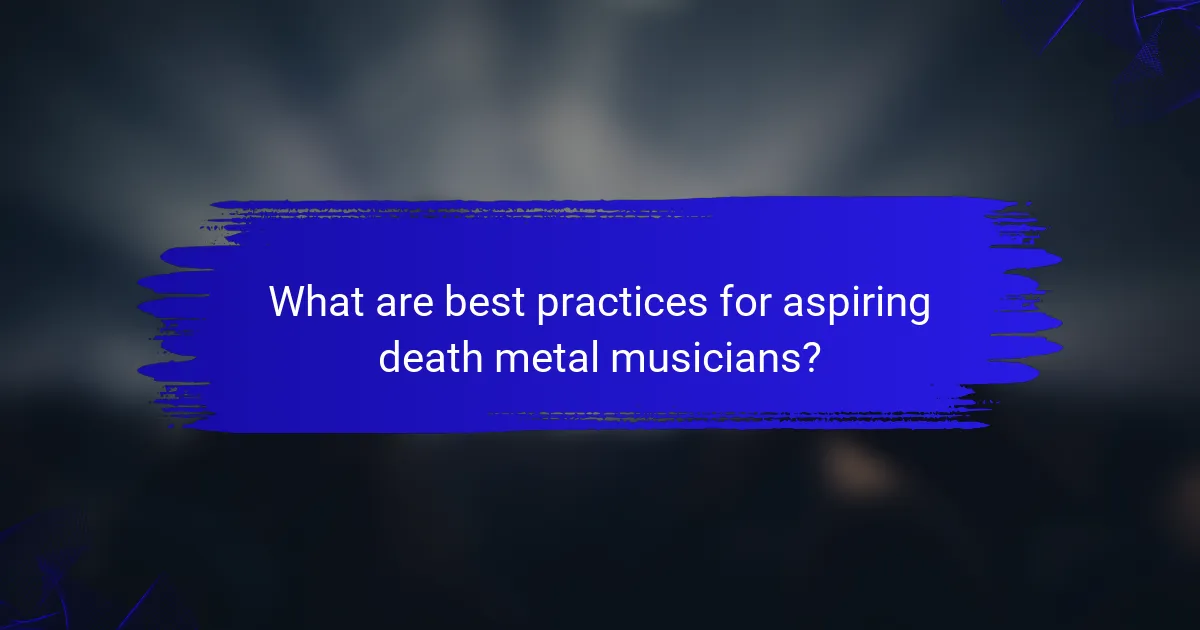
What are best practices for aspiring death metal musicians?
Aspiring death metal musicians should focus on developing technical proficiency, understanding genre influences, and studying iconic bands. Mastering intricate guitar techniques and rapid drumming is essential. Influences include thrash metal, punk, and classical music, which shape the sound. Analyzing bands like Death, Cannibal Corpse, and Morbid Angel provides insights into songwriting and performance styles. Collaborating with other musicians and participating in live shows can enhance skills and build a network.
Which techniques should musicians focus on developing?
Musicians should focus on developing techniques such as precise rhythm, complex time signatures, and advanced guitar skills. Mastering these elements enhances the technical proficiency essential in death metal. Additionally, understanding dynamics and incorporating varied vocal styles can elevate their performance. Iconic bands often demonstrate these techniques, showcasing their importance in the genre.
How can bands effectively market themselves in the digital age?
Bands can effectively market themselves in the digital age by leveraging social media, streaming platforms, and engaging with fans. Social media allows for direct interaction, promoting new releases, and sharing behind-the-scenes content. Streaming platforms provide accessibility to a wider audience, increasing exposure. Engaging with fans through live streams and Q&A sessions fosters loyalty and community. Collaborations with influencers and other artists can also enhance visibility. Additionally, utilizing analytics tools helps bands understand their audience and tailor their marketing strategies accordingly.